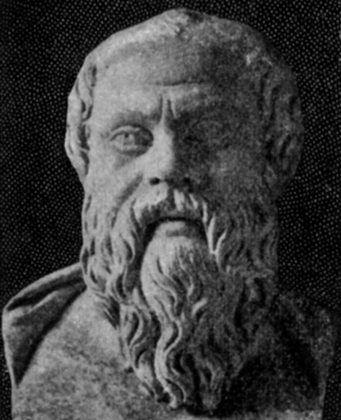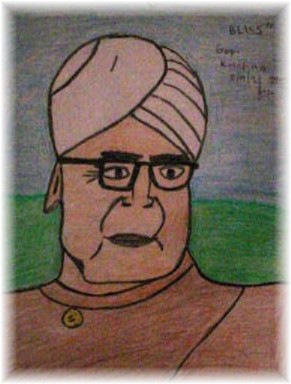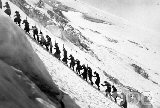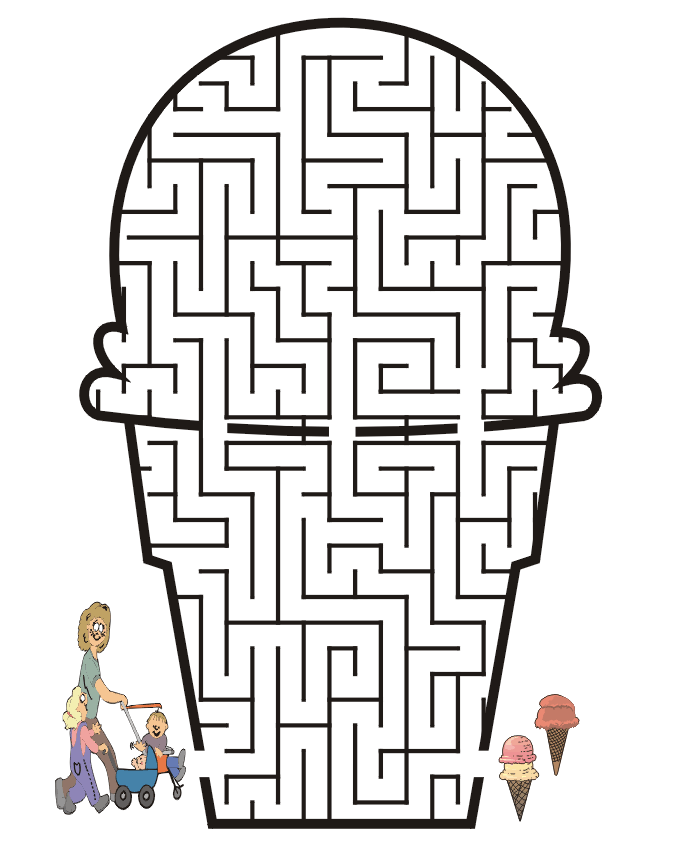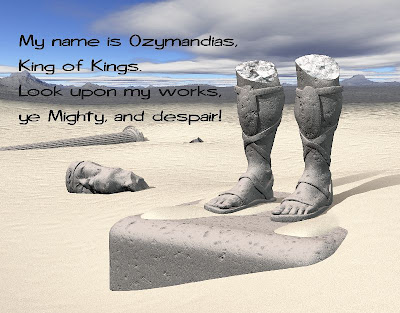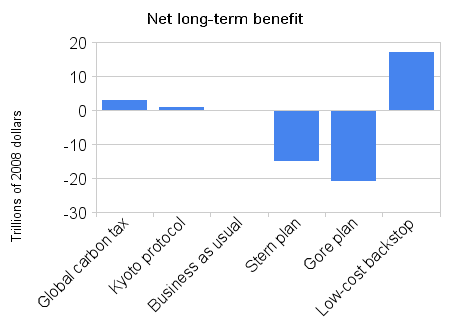

|
Science and faith “He that will believe only what he can fully comprehend must have a long head or a very short creed.” Pierre Teilhard de Chardin, born this day in 1881, was a Jesuit scientist, a thinker and a visionary, whose empirical findings constantly reinforced his faith. Long before the Internet, before the first published conceptualization of Lovelock’s Gaia, Teilhard spoke of the noosphere, a ‘planetary thinking network — an interlinked system of consciousness and information, a global net of self-awareness, instantaneous feedback, and planetary communication.’ |
1 May 2008
|
||
|
2000 years before Darwin In those days the earth attempted also to produce a host of monsters, grotesque in build and aspect — hermaphrodites, halfway between the sexes yet cut off from either, creatures bereft of feet or dispossessed of hands, dumb, mouthless brutes, or eyeless and blind, or disabled by the adhesion of their limbs to the trunk. These and other such monstrous and misshapen births were created. But all in vein. Nature debarred them from increase.body... Many species must have died out altogether and failed to reproduce their kind. Every species that you now see drawing the breath of life has been protected and preserved from the beginning of the world either by cunning or by prowess or by speed. The surly breed of lions, for instance, in their native ferocity have been preserved by prowess, the fox by cunning and the stag by flight. — from the
De Rerum
Natura of Lucretius,
ca 55 BC, tr
William
Ellery Leonard |
2 May 2008 |
||
|
Requisite epiphany ...transitory glimpses of another world beyond the senses, to which access is possible in certain states of mind, have a history extending to thousands of years, covering perhaps the whole period from the dawn of civilization to the present day. There is no branch of knowledge to which the culture of the past held so tenaciously as the secrets relating to this great mystery. On the inner walls of the pyramid, in the ruins of Sumer and the relics of the Indus Valley, mingled with the ashes of populations that lived and loved, like us, for thousands of years, there still exist symbols and signs to show that more was known about this mighty secret than is known even to the leaders of thought today. ...a thin veil separates now the more evolved section of our race from the ineffable vision of a hidden Reality. This unique visionary experience is absolutely necessary for leaders and intellectual guides of humankind.... “The conscious division and separation of the self from the divine being, the object from the subjet, which is the normal condition of unregenerate humanity,” says Dr. S. Radhakrishnan, “is broken down...A lightning flash, a sudden flame of incandescence, throws a momentary but eternal gleam on life in time. A strange quietness enters the soul, a great peace invades its being;. The vision, the spark, the supreme moment of unification or conscious realization sets the whole being ablaze with perfect purpose. The supreme awareness, the intimately felt presence, brings with it a rapture beyond joy, a knowledge beyond reason, a sensation more intense than that of life itself, infinite in peace and harmony.” This illuminating release from the thralldom of sense is the real aim of mystical experience. It is only here that the Saving Light that illumines the path, aligned for mankind can be encountered. This makes religion as necessary for the survival of the race as the breath of life itself... from The Dawn of a New Science, by Gopi Krishna |
3 May 2008 |
||
|
The folly of youth In youth we are too naïve to know what will work and what will not work, so we try all kinds of things. Our efficiency is low, our failure rate high. In maturity, we are wise enough to know what will work, to avoid pitfalls, to place our trust in methods and practices that are known to be reliable. I think I’ll stick with the folly just a bit longer. — Josh Mitteldorf |
4 May 2008
|
||
|
Depression — Inspiration — Transcendence Søren Kierkegaard, born this day in 1813, struggled mightily with melancholia through his life, and left us a faithful record both of his despair and of the transcendent, mystical visions which he savored as rare flashes of another reality. I feel as if I were a piece in a game of chess, when my opponent says of it: That piece cannot be moved. In addition to my other numerous acquaintances, I have one more intimate confidant.... My depression is the most faithful mistress I have known — no wonder, then, that I return the love. What is a poet? An unhappy person who conceals profound anguish in his heart but whose lips are so formed that as sighs and cries pass over them they sound like beautiful music. Just as in earthly life lovers long for the moment when they are able to breathe forth their love for each other, to let their souls blend in a soft whisper, so the mystic longs for the moment when in prayer he can, as it were, creep into God. Never cease loving a person, and never give up hope for him, for even the prodigal son who had fallen most low, could still be saved; the bitterest enemy and also he who was your friend could again be your friend; love that has grown cold can kindle. To dare is to lose one’s footing momentarily; note to dare is to lose oneself. |
5 May 2008
|
||
|
How did space come to be three-dimensional? Imagine a landscape composed of microscopic triangular structures
that constantly rearrange themselves into new patterns. Seen from afar,
the landscape looks perfectly smooth, but up close it is a churning
cauldron of strange geometries. This deceptively simple model is at the
heart of a new theory called causal dynamical triangulation (CDT), which
has emerged as a promising approach to solving the most vexing problem
in physics — unifying the laws of gravity with those of quantum
mechanics. Just as you can glue six equilateral triangles together at a point to
make a piece of flat space, so CDT can produce flat, positively curved
or negatively curved space-time by allowing different numbers of
4-simplices to meet at a point. The triangles are not physical objects;
rather, they are a mathematical and computational tool - and they lead
to compelling results. The crucial step in deriving space-time on a
large scale is to “sum over” all possible configurations of these
triangles. This is in keeping with the spirit of
Richard Feynman’s
approach to quantum mechanics, in which every possible path of a
particle must be added up to calculate how it gets from A to B. Back in
the late 1970s, a similar approach to space-time was taken by Stephen
Hawking at the University of Cambridge, but it failed as it ended up
producing universes that had either no dimensions or an infinite number
of them.
Wikipedia entry on CDT |
6 May 2008
|
||
|
Brahms and Tchaikovsky Brahms, the austere and methodical German classicist, and Tchaikovsky the ardent Russian romantic were both born May 7th, seven years apart. In truth, Tchaikovsky was thoroughly a master of classical forms, and Brahms’s music is as deeply passionate as any romantic of his era. Tchaikovsky’s most popular piano works derive from a commission he received to write a piece on the theme of each month of the year. He tossed them off, each the night before it was due, and they came out as little gems, perfectly formed. Listen to May from The Seasons as orchestrated by Alexander Gauk. Brahms’s most popular piano pieces were also written as a frill, and Brahms did not consider them serious enough to be assigned an opus number. Listen to Hungarian Dance #11, orchestrated by Brahms himself (I think) as you watch the evolution of Brahms’s appearance over his life. |
7 May 2008
|
||
|
The Habit of Perfection
|
8 May 2008
|
||
|
Gaviotas — a community modeling sustainability for world development The eastern savannas of war-ravaged Colombia, known as the llanos, are among the most brutal environments on Earth, an unlikely setting for one of the most hopeful environmental stories ever told. Here, more than thirty-five years ago, an intrepid visionary named Paolo Lugari set out to create a village that could sustain itself agriculturally, economically, and artistically. He reasoned that if a community could survive in the Colombian llanos, it would be possible to live anywhere. The new village was named after the graceful river terns common in the area, los gaviotas. The early inhabitants of Gaviotas soon realized that if they wanted even basic necessities, they would need to be very resourceful. So they invented wind turbines that convert mild breezes into energy, super-efficient pumps that tap previously inaccessible sources of water, and solar kettles that sterilize drinking water using the furious heat of the tropical sun. Gaviotas is a village of about 200 people in Colombia, South America. For three decades, Gaviotans - peasants, scientists, artists, and former street kids - have struggled to build an oasis of imagination and sustainability in the remote, barren savannas of eastern Colombia, an area ravaged by political terror. They have planted millions of trees, thus regenerating an indigenous rainforest. They farm organically and use wind and solar power. Every family enjoys free housing, community meals, and schooling. There are no weapons, no police, no jail. There is no mayor. |
9 May 2008
|
||
|
Birthday dialog – What do you want for your birthday, Josh? – Immortality. – I’d like to give you immortality, but it’s not something that you can ever have. Immortality, like infinity, never ‘arrives’. – Don’t get smart with me. You know what I mean. I don't want to die. – This isn’t some clever technicality. You’re no closer to infinite time now than you were when you were born, and you will be no closer in 10,000 years than you are now. Right now, you’re not dead. So for now, your wish is fulfilled — or as much of it as is logically possible. For now. – I want to still be alive in 10,000 years. – OK. You will be. – I don’t believe you. – What would it take to convince you? – There isn’t anything that can convince me. It’s not true. – What do you want for your birthday, Josh? – How about, sufficiency of time? – Done! You have all the time you need for all that you want to do. – I don’t believe you. – I’m beginning to get the impression that what you really want is belief. – I don’t want to believe something that’s not true. – Would you be happier, perhaps, if you knew for certain what was going to happen in the future? – I don’t think I want that. Life would be awfully dull if I knew in advance everything that was going to happen. – Then maybe it’s not a question of assurance that you will live forever. Aren’t you talking about faith? – I said: No delusions. I live in reality. – Look, Josh, when you make birthday wishes, no one is asking you to confine yourself to reality. Ask for the moon! But at least make some sense. Ask for something that is within the realm of logical possibility. – I want a young body. There’s no contradiction in that. – Healthy, robust and pain-free. Check again! – Faith grounded in reason. I want to have reasonable grounds for believing that the medical technology to counter aging will develop in time to keep me young. I want to believe in an ever-expanding web of connections, and an ever-deepening wisdom. – For yourself? – For myself and all beings. – Josh, your faith is well-grounded. It is fear that is irrational. You have every reasonable cause for hope. – I wish I could believe you. – Granted! |
10 May 2008
|
||
|
That means you and me... ‘...religious feeling is a natural state in human beings....This mystical feeling is almost always present in the intelligent human mind.’ Gopi Krishna saw a directed purpose in biological evolution, and indeed in the evolution of the universe. He told us that consciousness is primary, preceding matter, and that material forms are evolving under the direction of consciousness in order to more fully realize its nature. His ideas are deeply at odds with the prevailing scientific culture, but there exists some scientific support for this position:
|
11 May 2008 |
||
|
Attend to the downtrodden. Visit the prisons. Christians are entreated by their faith to serve the poor and the oppressed, but in our culture this behavior leads not only to ostracism but persecution. Bishop Hugh Latimer, born this day in 1485 (or maybe 1490), was burned at the stake for his passionate sermons in advocacy for the poor (and, what is far worse, he practiced what he preached). Gutta cavat lapidem non vi, sed saepe cadendo.* “The drop of rain maketh a hole in the stone, not by violence, but by oft falling.” * The Latin is attributed to Ovid, the English version to Latimer. |
12 May 2008
|
||
|
Shooting beyond the tangible Many years ago I saw, between sleeping and waking, a woman of incredible beauty shooting an arrow into the sky, and from the moment when I made my first guess at her meaning I have thought much of the difference between the winding movement of Nature and the straight line...described as the mark of saint or sage. I think that we who are poets and artists, not being permitted to shoot beyond the tangible, must go from desire to weariness and so to desire again, and live but for the moment when vision comes to our weariness like terrible lightning, in the humility of the brutes. I do not doubt those heaving circles, those winding arcs, whether in one man’s life or in that of an age, are mathematical, and that some in the world, or beyond the world, have foreknown the event and pricked upon the calendar the life-span of a Christ, a Buddha, a Napoleon: that every movement in feeling or in thought, prepares in the dark by its own increasing clarity and confidence its own executioner. We seek reality with the slow toil of our weakness and are smitten from the boundless and unforeseen. Only when we are saint or sage, and renounce experience itself, can we, in imagery of the Christian Cabbala, leave the sudden lightning and the path of the serpent and become the bowman who aims his arrow at the centre of the sun. – W. B. Yeats, 1865-1939 |
13 May 2008
|
||
|
Ramanujan was an early 20th century mathematician who spontaneously wrote down algebraic formulas involving infinite series, which subsequent generations required months of patient logic to prove (or, occasionally, disprove). You can only find truth with logic if you have already found truth
without it. People mistakenly assume that their thinking is done by their head;
it is actually done by the heart which first dictates the conclusion,
then commands the head to provide the reasoning that will defend it. The intuitive mind is a sacred gift and the rational mind is a faithful
servant. We have created a society that honors the servant and has
forgotten the gift. |
14 May 2008
|
||
|
Structured Procrastination I have been intending to write this essay for months. Why am I finally doing it? Because I finally found some uncommitted time? Wrong. I have papers to grade, textbook orders to fill out, an NSF proposal to referee, dissertation drafts to read. I am working on this essay as a way of not doing all of those things. This is the essence of what I call structured procrastination, an amazing strategy I have discovered that converts procrastinators into effective human beings, respected and admired for all that they can accomplish and the good use they make of time. All procrastinators put off things they have to do. Structured procrastination is the art of making this bad trait work for you. The key idea is that procrastinating does not mean doing absolutely nothing. Procrastinators seldom do absolutely nothing; they do marginally useful things, like gardening or sharpening pencils or making a diagram of how they will reorganize their files when they get around to it. Why does the procrastinator do these things? Because they are a way of not doing something more important. If all the procrastinator had left to do was to sharpen some pencils, no force on earth could get him do it. However, the procrastinator can be motivated to do difficult, timely and important tasks, as long as these tasks are a way of not doing something more important. — from the blog of John Perry |
15 May 2008
|
||
|
Pairs of shoes My future lives come to me in dreams These dreams — my other selves Pairs of shoes from yesterday will come tomorrow Tonight I decide to open myself to these dreams, I feel empty as a newborn animal. — Nguyễn Quyền (1869–1941) was a Vietnamese scholar-gentry anti-colonial revolutionary activist who advocated independence from French colonial rule. This poem was translated from the Vietnamese by Ben Tran. |
16 May 2008
|
||
|
What is it that natural selection selects? For more than a century, evolutionary theory has been doing precise calculations of fitness based on the presumption that we know what fitness is. Fitness is fertility — leaving more offspring behind, faster. There have been hints all along that nature is smarter than this, that she is selecting diversity, cooperation, the ability to survive disruptive surprises, whole ecosystems that are robust and resilient. One of the great paradoxes of evolutionary theory is that evolution itself seems to be a highly evolved process, with adaptations that serve no other purpose than to promote a better rate of adaptation in the future. Last month, a paper was published demonstrating directly just how wrong evolutionary theory has been. A single hormone was discovered that decreases fertility of mice by one third. Normal mice have this gene turned on, and by switching it off, researchers were able to create a line of mice half again as fertile as wild type. In other words, the means to much greater fertility is ready and waiting in the mouse genome, and natural selection has elected to keep it turned off. If science were only quick and efficient, this would be the last nail in the coffin of the hypothesis that fitness = fertility. But scientific culture is conservative, and we may have to wait a decade or two.
Article in Science Daily yesterday |
17 May 2008
|
||
|
We continually create narrative histories from our life experience. We organize our memories into stories and we surmise the appropriate morals. We use these as lessons to guide us in the future, and from the stories we construct a social identity, a presentation of ourselves to others, which may even be the most real and durable basis for the way we think about ‘who we are’. Animals may be fully conscious, but living from moment to moment, without this ability to construct and store temporal narratives. Clive Wearing is a British composer and organist, who lost his ability to create temporal narratives from his experiences due to a viral infection in his brain (in 1985). He continually had the impression that each moment of his life was an awakening from a long sleep. (It is a fascinating detail in its own right that he never lost the ability to play the organ beautifully, or even to improvise new creations at the keyboard.) He became desperately frustrated and depressed about his situation. He lost several years when he was institutionalized and sedated, because his outbursts and his rage were too upsetting and inconvenient even for his devoted and loving wife. But he emerged to more thoughtful and patient care, and eventually transformed his disability into a remarkable capacity to see the world through childlike eyes, fresh and wondrous in each new moment. Ambitious human individuals have striven to create beauty, to find patterns in nature and to deepen intellectual understanding, to lead societies to greater cooperation, or simply to amass great power and wealth. And yet to regard the world with a transcendent sense of mystery and awe seems to be as great an aspiration as any, and accessible to us all. |
18 May 2008 |
||
|
Think big The most realistic way for you to tackle greater goals is to enlarge your notion of ‘you’. — Josh Mitteldorf |
19 May 2008 |
||
|
Hazy Moon Last night I almost hugged the hazy moon, She rose red, round, and huge She loomed listening to the pine pitch Two hands from the horizon For a moment, free She hovered like a lover on a balcony Always she returned |
20 May 2008
|
||
|
Every modern state needs profound democratic reforms. “Our country, like every modern state, needs profound democratic reforms. It needs political and ideological pluralism, a mixed economy and protection of human rights and the opening up of society.” — Andrei Sakharov, born this day in 1921, contributed ideas to cosmology and energy technology, in addition to theoretical nuclear physics. His intellect was so widely admired that he could not be effectively silenced when he spoke out against abuses of the Soviet regime. In 1975, he was not permitted to leave the Soviet Union to accept the Nobel Peace Prize. |
21 May 2008
|
||
|
The Ice Cream Meditation ...I suggested to Dr. [James W.] Boyd that he should meditate on the feelings. Here what I mean by feelings is not necessarily gross feelings like anger or anxiety, but any mental or physical feeling like pleasure or pain. The following was my instruction: Being aware of your feelings is traditionally know as vedanaanupassana satipatthana. When you eat ice cream you enjoy the taste of it. That is rasa vedana. Rather than letting your thoughts wander about something else or somewhere else, keep your thoughts on the action of eating ice cream and the taste of it... By the way, one does not have to sit cross-legged in a lotus position to eat ice cream. Let us try it. Dr Boyd agreed. After doing satipatthana meditation on eating ice cream he sat at his computer and recorded his experience. His computer gives this report: I purposely selected one of my favourite flavours of ice cream, double dip, I was quickly aware of my tongue, the taste of cold ice cream on it. I tried to be observant of my response to the taste, and eventually saw that just as I swallowed there was a desire for more. As I tried to continue that awareness of attachment to the taste, on about three occasions I became aware that as I paid attention to the desire, it was neutralised somewhat. I asked myself at those moments if I craved another bite; there was no sense of craving. Habitual inattention brought me in and out of this awareness, however, even with something so appealing as ice cream. — Shanta Ratnayaka, writing at Buddhanet Editor’s comment: Vipassana meditation can be used to suck all the pleasure out of life experiences, but it doesn’t have to be this way. In fact, I’m suspicious of someone who says he has approached an experiment with an open mind, but reports on its completion exactly what the textbook said was supposed to happen. I have found that intention can be used to enhance and intensify pleasurable sensation, to savour sensual moments and create more richly satisfying experiences. — JJM |
22 May 2008
|
||
|
Advice to graduates The secret is finding the balance between going out and getting what you want and accepting the thing that actually comes your way. If you’re trying to figure out what comes next, I urge you to turn off everything that has an ‘off’ switch and listen. Make up some big plans and be willing to change them on a dime. Identify your heart’s truest desire and don’t change that for anything. Be proud of yourself for the work that you’ve done; be grateful to the people who helped you do it; write to us and let us know how you are. |
23 May 2008
|
||
|
Bohm vs Bohr A paper published last month proposes a cosmological test that would distinguish the standard Copenhagen Interpretation of quantum mechanics from the iconoclastic Bohm interpretation. Say wha...? Since 1930, physicists have agreed that the world is quantum mechanical. But QM is a set of rules for calculating the results of experiments, they say, not a picture of reality. For example, there are no electrons in the sense of a particle that moves from one place to another. There is only a probability of detecting an electron in a given measurement, given the results of any previous measurement. That is the standard interpretation of QM, the ‘Copenhagen interpretation’, attributed to Niels Bohr (who was really the grandfather of QM, not the father) and Werner Heisenberg (one of three fathers). There’s an alternative view, first articulated by Louis de Broglie and elaborated into a fully-consistent worldview by David Bohm. In the alternative view, all the equations are the same and the predictions are the same as the standard view, but electrons are real, and they move through the world, much the way we imagine a baseball that flies through the air from the pitcher’s hand to the catcher’s glove moves continuously across the infield. Why doesn’t everyone embrace the de Broglie-Bohm view? Part of it is history, the power of tradition and reverence for Bohr. Another part is an unsettling feature of the Bohm picture, called ‘non-locality’. The way any particle moves is affected by every other particle in the universe. Every atom that once had a brush with a particle in the neighborhood of our electron, or that may in the future have a brush with such a particle (and these effects from other times and places aren’t necessarily tiny). (If you saw the movie ‘What the *@$!# do We Know?’, non-locality is a feature of the world that was explained several times, in different ways.) Because of rules like conservation of momentum and energy, there are things we can calculate about the world quite accurately using classical thinking. This gives the illusion of a mechanical world with physical causes and effects that can be understood in a reductionist way, one particle at a time. But in fact, the atomic world is wildly holistic, and some physicists say that the workings of our brains are evolved to harness these non-local connections through time and space. So we have a choice between
The equations and predictions of the two world-views are not quite identical, says Antony Valentini. In particular, they would have caused the inflation in the first moments of the Big Bang to take place in a different way. And by looking carefully at the subtle patterns imprinted on the Cosmic Microwave Background, we should be able to distinguish which of the two world-views is correct. Measurements available at present suggest that Bohm beats Bohr, but more accurate measurements that might be made in the next few years should be able to distinguish the two unambiguously. …so long as we believe in the inflationary version of the Big Bang. |
24 May 2008
|
||
|
Everyone’s favorite iconoclast I honor the man who wrote My cow milks me. I admire the youthful Emerson who proclaimed I will no longer confer, differ, refer, defer, prefer or suffer—the Emerson who with those words promised a lifelong resolve against indifference, dullness, detachment, disregard. The man who discovered early on that passionless thought builds the sepulchres of the fathers. He who asked Why should not we also enjoy an original relation to the universe? as fresh as that known to Plato and Pythagoras, Lucretius and Zoroaster, Buddha and Jesus, Meng Tsu and Marcus Aurelius, Dante and Milton, Goethe and Kant who went before? The radical contrarian who, even as he read over the course of a long life through so much of the world's literature, believed always that the journey is only in the footfall, that the masterpiece is only in the word read now, that all literature is yet to be written... I applaud the audacity of the man who wrote Beware when the great God lets loose a new thinker on this planet, the same who deduced from Stoic and Quaker and Islamic thought the unhampered personal philosophy that insists the universe is the externalization of the soul. He who would weave his own religion from the threads, the brambles, the seeded shafts of various others, looking less for differences among mankind’s doctrines than the convergences which he found everywhere... To conform or not to conform, this is the question I celebrate in him. For nonconformity the world whips you with its displeasure, and yet, isn’t it also true that contempt is the malign gift the public eventually bestows upon its conformers? Emerson who thus proposed you act as you will, and let the world go its own way: What I must do is all that concerns me, not what the people think. What gives this intimate declaration of independence such greatness, though, is that it does not come with an invitation to retire from society, to seek hermitage, but to walk straight into society with your autonomous head held high. It is easy in the world to live after the world's opinion; it is easy in solitude to live after our own; but the great man is he who in the midst of the crowd keeps with perfect sweetness the independence of solitude. — excerpted from Bradford Morrow’s page on R W Emerson, born this day in 1803. |
25 May 2008
|
||
|
Picnic at the beach Wars have always been sold to the people on false pretenses. The slaughter of innocents and the wanton disruption of productive lives are elided in favor of a myth in which the Homeland has been threatened, causing noble citizens to unite in its defense. Just imagine if the combatants on both sides of a war were receiving the same news, a common basis in fact about the circumstances of an original dispute, and about the events that unfolded as the war progresses... Visionaries and dreamers have talked about the end of war ever since the beginning of war, while government propagandists sell each new war as a ‘the war to end all war’. But the rise of international communications networks in recent years has provided a basis for optimism that this abominable tradition of mendacity may not be sustainable. War cannot abide truth, and deception cannot survive the free flow of communication. — Josh Mitteldorf |
26 May 2008
|
||
|
Meditation is good for you Despite the fact that it undermines a system of credentialed, medical ‘providers’... Despite the fact that no pharmaceutical company can get rich from it... Despite the fact that its mechanisms of action are poorly understood and its origins are suspiciously mystical... Buddhist meditation has been recognized with traditional psychiatric measures of effectiveness as a therapy with a high rate of response for depression, chronic pain, anxiety and OCD, with no risks or side-effects |
27 May 2008
|
||
|
Time I am Ozymandias,
King of kings. I met a traveler from an antique land — Percy Bysshe Shelley, 1792-1822 —————————————————— To Time it never seems that he is brave
What now is inland shall be ocean isle,
I could give all to Time except – except — Robert Frost, 1874-1963 |
28 May 2008 |
||
|
The only way I have ever understood, broken free, emerged, healed, forgiven, flourished, and grown powerful is by asking the hardest questions and then living into the answers through opening up to my own terror and transmuting it into creativity. — Sue Monk Kidd, author of The Secret Life of Bees |
29 May 2008
|
||
|
Can you construct a sentence using the words ‘optimistic’ and ‘Global Warming’? Freeman Dyson is a venerable scientific visionary, a theoretical physicist from the heyday of quantum theory who has grown into a philosopher-scientist for our age. (His most famous contribution to science came 60 years ago: After Julian Schwinger and Richard Feynman came up with dramatically different formulations of relativistic quantum mechanics, Dyson proved that the two theories are actually equivalent. Book by Silvan Schweber) In the current issue of New York Review, Dyson outlines a wise and astute perspective on contrasting economic and environmental views of global warming. The central question: How can we reconcile the environmentalist’s view that we are stewards of the earth for future generations with the economist’s propensity to discount every long-term cost to a minuscule present value? Dyson finds a key to low-cost, long-term solutions in the wiggles of the CO2 curve (click to enlarge figure at right). The only plausible explanation of the annual wiggle and its variation with latitude is that it is due to the seasonal growth and decay of annual vegetation, especially deciduous forests, in temperate latitudes north and south…The wiggle is giving us a direct measurement of the quantity of carbon that is absorbed from the atmosphere each summer north and south by growing vegetation, and returned each winter to the atmosphere by dying and decaying vegetation. The quantity is large, as we see directly from the Point Barrow measurements. Without committing to a specific technology, Dyson points us in the direction of a remedy for global warming: Smart, incisive technology must be used in a large-scale intervention to induce trees to pull more CO2 from the air each summer, and return less CO2 to the air when their leaves decay each fall.
Economic consequences of different Global Warming strategies, |
30 May 2008 |
||
|
Is the brain really necessary? Scientists who study Alzheimer’s disease note the existence of plaques and the loss of neurons in victims of the disease. What they don’t like to emphasize is that there are also people who seem to have this same profound damage to the brain, but have little or no symptoms of cognitive impairment. Back in 1980, Roger Lewin, writing in Science Magazine, described the speculations of John Lorber of Sheffield University. “Lorber believes that his observations on a series of hydrocephalics who have severely reduced brain tissue throws into question many traditional notions about the brain, both in clinical and scientific terms. “‘There’s a young student at this university,’
says Lorber, ‘who has an IQ of 126, has gained a first-class honors
degree in mathematics, and is socially completely normal. And yet
the boy has virtually no brain...When we did a brain scan on him, we
saw that instead of the normal 4.5-cm thickness of brain tissue between
the ventricles and the cortical surface, there was just a thin layer of
mantle measuring a millimeter or so. His cranium is filled “‘I can’t say whether the mathematics student has a brain weighing 50 grams or 150 grams, but it’s clear that it is nowhere near the normal 1.5 kilograms.’” I would like to think that ‘I’ am distinct from ‘my brain’, if only because it bears on questions of psychic experience and whether there is a continuity of experience after death. Still, I’m going to keep wearing a helmet when I go out on my bicycle. |
31 May 2008
|










